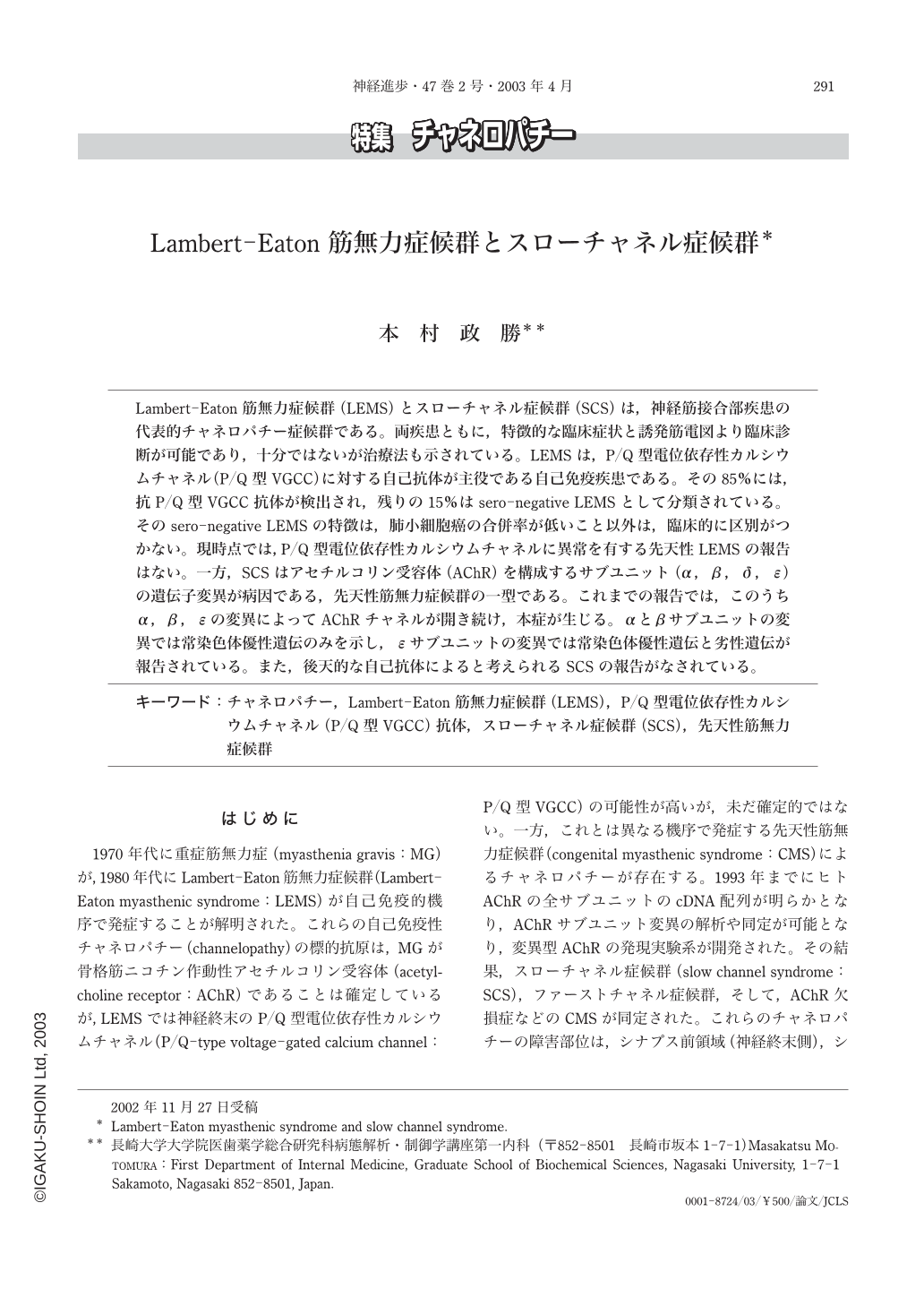Japanese
English
- 有料閲覧
- Abstract 文献概要
- 1ページ目 Look Inside
Lambert-Eaton筋無力症候群(LEMS)とスローチャネル症候群(SCS)は,神経筋接合部疾患の代表的チャネロパチー症候群である。両疾患ともに,特徴的な臨床症状と誘発筋電図より臨床診断が可能であり,十分ではないが治療法も示されている。LEMSは,P/Q型電位依存性カルシウムチャネル(P/Q型VGCC)に対する自己抗体が主役である自己免疫疾患である。その85%には,抗P/Q型VGCC抗体が検出され,残りの15%はsero-negative LEMSとして分類されている。そのsero-negative LEMSの特徴は,肺小細胞癌の合併率が低いこと以外は,臨床的に区別がつかない。現時点では,P/Q型電位依存性カルシウムチャネルに異常を有する先天性LEMSの報告はない。一方,SCSはアセチルコリン受容体(AChR)を構成するサブユニット(α,β,δ,ε)の遺伝子変異が病因である,先天性筋無力症候群の一型である。これまでの報告では,このうちα,β,εの変異によってAChRチャネルが開き続け,本症が生じる。αとβサブユニットの変異では常染色体優性遺伝のみを示し,εサブユニットの変異では常染色体優性遺伝と劣性遺伝が報告されている。また,後天的な自己抗体によると考えられるSCSの報告がなされている。
はじめに
1970年代に重症筋無力症(myasthenia gravis:MG)が,1980年代にLambert-Eaton筋無力症候群(Lambert-Eaton myasthenic syndrome:LEMS)が自己免疫的機序で発症することが解明された。これらの自己免疫性チャネロパチー(channelopathy)の標的抗原は,MGが骨格筋ニコチン作動性アセチルコリン受容体(acetylcholine receptor:AChR)であることは確定しているが,LEMSでは神経終末のP/Q型電位依存性カルシウムチャネル(P/Q-type voltage-gated calcium channel:P/Q型VGCC)の可能性が高いが,未だ確定的ではない。一方,これとは異なる機序で発症する先天性筋無力症候群(congenital myasthenic syndrome:CMS)によるチャネロパチーが存在する。1993年までにヒトAChRの全サブユニットのcDNA配列が明らかとなり,AChRサブユニット変異の解析や同定が可能となり,変異型AChRの発現実験系が開発された。その結果,スローチャネル症候群(slow channel syndrome:SCS),ファーストチャネル症候群,そして,AChR欠損症などのCMSが同定された。これらのチャネロパチーの障害部位は,シナプス前領域(神経終末側),シナプス性(シナプス間隙),そして,シナプス後領域(筋肉側)に分類される。本稿では,シナプス前領域の代表であるLEMSと,シナプス後領域のSCSについて,最近の知見に基づいて,その発症分子メカニズムについて概説する。
The Lambert-Eaton myasthenic syndrome(LEMS)and slow channel syndrome(SCS)are representative channelopathies of the neuromuscular junction. Both diseases are diagnosed by characteristic clinical signs and electrical findings and are amenable to treatment. LEMS is an autoimmune disorder in which IgG autoantibodies lead to presynaptic P/Q-type voltage-gated calcium channel(VGCC)loss. As a paraneoplastic disorder, 60%of patients with LEMS have samll cell lung carcinomas(SCLC)that express functional VGCCs. Recent results strongly suggest that the antibodies to P/Q-type VGCC are the principal pathogenic factors in LEMS. Here, we present pathophysiology and treatment of LEMS patients. Proximal weakness, depressed tendon reflexes, autonomic symptoms, and electrical posttetanic potentiation together are essential to accurately diagnose LEMS. The diagnosis is established immunologically by the presence of anti-P/Q-type VGCC antibodies, detected using the 125I-ω-conotoxin MVIIC radioimmunoassay, which will be present in 85%of LEMS patients. The remaining 15%of patients are classified as seronegative. Except for the indication that SCLC is less common in seronegative patients, no significant differences were found in the clinical characteristics of patients who had or did not have P/Q-type VGCC antibodies. At present, there is no report of a congenital LEMS patient whose P/Q-type VGCC gene has genetic mutations. On the other hand, the slow channel syndrome is a hereditary disease caused by mutations in the subunits of the acetylcholine receptor that prolong the opening time of the acetylcholine-induced ion channel. The clinical diagnosis of SCS is suggested by a positive family history, specific muscle weakness, the decremental response to repetitive nerve stimulation in clinically affected muscles, and the repetitive compound muscle action potential to a single nerve stimulus. Recently, a couple of studies reported a patient with clinical and electrophysiological features of SCS and positive AChR antibodies and suggested that AChR antibodies altered the function of AChR, and this new form of myasthenia gravis was termed acquired SCS.

Copyright © 2003, Igaku-Shoin Ltd. All rights reserved.


